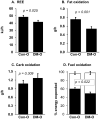Lower resting energy expenditure and fat oxidation in Native American and Hispanic infants born to mothers with diabetes
- PMID: 25648295
- PMCID: PMC4380761
- DOI: 10.1016/j.jpeds.2014.12.036
Lower resting energy expenditure and fat oxidation in Native American and Hispanic infants born to mothers with diabetes
Abstract
Objective: To determine whether exposure to diabetes in utero affects resting energy expenditure (REE) and fuel oxidation in infants.
Study design: At 35 ± 5 days after birth, body composition and REE were measured in full-term offspring of Native American and Hispanic women with either well-controlled diabetes (13 girls, 11 boys) or normal healthy pregnancies (18 girls, 17 boys).
Results: Control of dysglycemia during gestation in the women with diabetes mellitus met current clinical standards, shown by average glycated hemoglobin (5.9 ± 0.2%; 40.6 ± 2.3 mmol/mol). Infant body mass (offspring of women with diabetes: 4.78 ± 0.13, control offspring: 4.56 ± 0.08 kg) and body fatness (offspring of women with diabetes: 25.2 ± 0.6, control offspring: 24.2 ± 0.5 %) did not differ between groups. REE, adjusted for lean body mass, was 14% lower in offspring of women with diabetes (41.7 ± 2.3 kJ/h) than control offspring (48.6 ± 2.0, P = .025). Fat oxidation was 26% lower in offspring of women with diabetes (0.54 ± 0.05 g/h) than control offspring (0.76 ± 0.04, P < .01) but carbohydrate oxidation did not differ. Thus, fat oxidation accounted for a lower fraction of REE in the offspring of women with diabetes (49 ± 4%) than control offspring (60 ± 3%, P = .022). Mothers with diabetes were older and had higher prepregnancy body mass index than control mothers.
Conclusions: Well-controlled maternal diabetes did not significantly affect body mass or composition of offspring at 1-month old. However, infants with mothers with diabetes had reduced REE and fat oxidation, which could contribute to adiposity and future disease risk. Further studies are needed to assess the impact differences in age and higher prepregnancy body mass index.
Copyright © 2015 Elsevier Inc. All rights reserved.
Figures

Similar articles
-
Late-pregnancy dysglycemia in obese pregnancies after negative testing for gestational diabetes and risk of future childhood overweight: An interim analysis from a longitudinal mother-child cohort study.PLoS Med. 2018 Oct 29;15(10):e1002681. doi: 10.1371/journal.pmed.1002681. eCollection 2018 Oct. PLoS Med. 2018. PMID: 30372451 Free PMC article.
-
Determinants of resting energy expenditure in young children.J Pediatr. 1994 Sep;125(3):362-7. doi: 10.1016/s0022-3476(05)83277-9. J Pediatr. 1994. PMID: 8071742
-
Increased fetal adiposity: a very sensitive marker of abnormal in utero development.Am J Obstet Gynecol. 2003 Dec;189(6):1698-704. doi: 10.1016/s0002-9378(03)00828-7. Am J Obstet Gynecol. 2003. PMID: 14710101
-
Offspring body size and metabolic profile - effects of lifestyle intervention in obese pregnant women.Dan Med J. 2014 Jul;61(7):B4893. Dan Med J. 2014. PMID: 25123127 Review.
-
Metabolically active components of fat-free mass and resting energy expenditure in humans: recent lessons from imaging technologies.Obes Rev. 2002 May;3(2):113-22. doi: 10.1046/j.1467-789x.2002.00057.x. Obes Rev. 2002. PMID: 12120418 Review.
Cited by
-
Genomics and Epigenomics of Gestational Diabetes Mellitus: Understanding the Molecular Pathways of the Disease Pathogenesis.Int J Mol Sci. 2022 Mar 23;23(7):3514. doi: 10.3390/ijms23073514. Int J Mol Sci. 2022. PMID: 35408874 Free PMC article. Review.
-
Oral feeding challenges of infants of diabetic mothers.Front Pediatr. 2024 Sep 9;12:1459197. doi: 10.3389/fped.2024.1459197. eCollection 2024. Front Pediatr. 2024. PMID: 39315360 Free PMC article. Review.
-
Collaborative implementation of a community-based exercise intervention with a partnering rural American Indian community.Clin Trials. 2019 Aug;16(4):391-398. doi: 10.1177/1740774519839066. Epub 2019 Apr 3. Clin Trials. 2019. PMID: 30939923 Free PMC article. Clinical Trial.
-
Spectrum of Phenotypes and Causes of Type 2 Diabetes in Children.Annu Rev Med. 2022 Jan 27;73:501-515. doi: 10.1146/annurev-med-042120-012033. Annu Rev Med. 2022. PMID: 35084995 Free PMC article. Review.
-
Maternal exercise increases infant resting energy expenditure: preliminary results.Int J Obes (Lond). 2024 Sep;48(9):1347-1350. doi: 10.1038/s41366-024-01560-0. Epub 2024 Jun 10. Int J Obes (Lond). 2024. PMID: 38858465 Free PMC article. Clinical Trial.
References
-
- Pettitt DJ, Baird HR, Aleck KA, Bennett PH, Knowler WC. Excessive obesity in offspring of Pima Indian women with diabetes during pregnancy. N Engl J Med. 1983;308:242–5. - PubMed
-
- Silverman BL, Metzger BE, Cho NH, Loeb CA. Impaired glucose tolerance in adolescent offspring of diabetic mothers. Relationship to fetal hyperinsulinism. Diabetes Care. 1995;18:611–7. - PubMed
Publication types
MeSH terms
Substances
Grants and funding
LinkOut - more resources
Full Text Sources
Other Literature Sources
Miscellaneous

